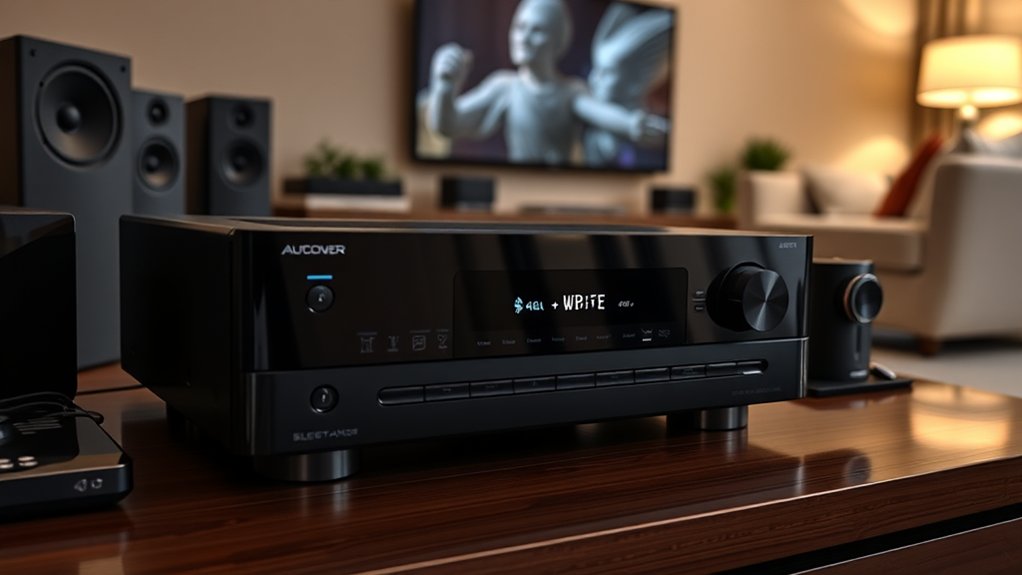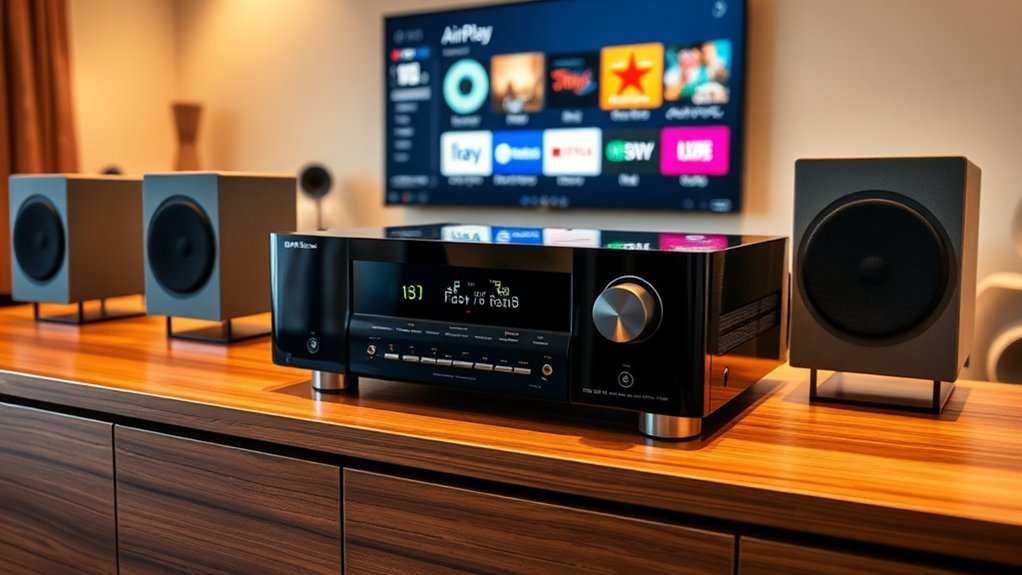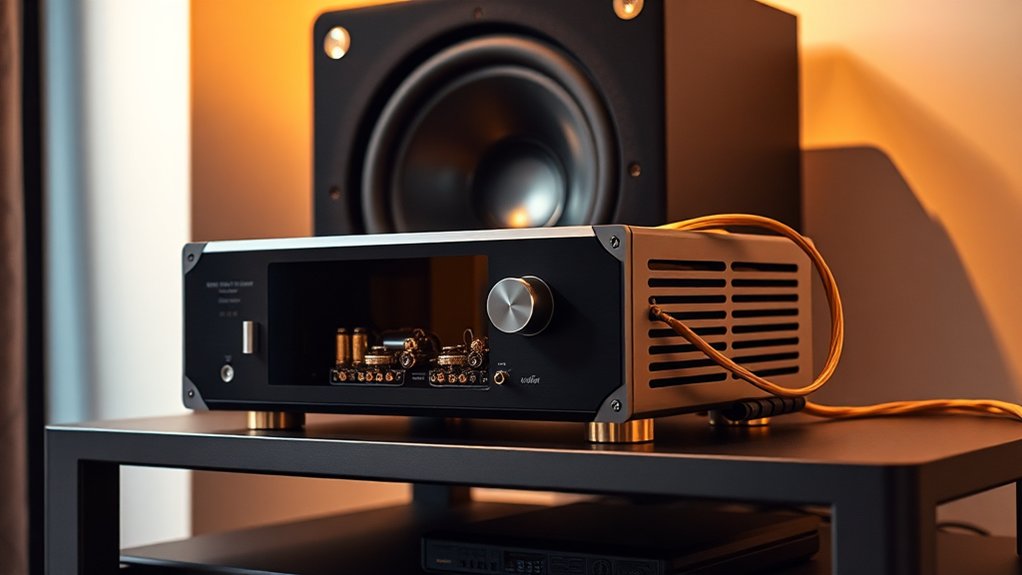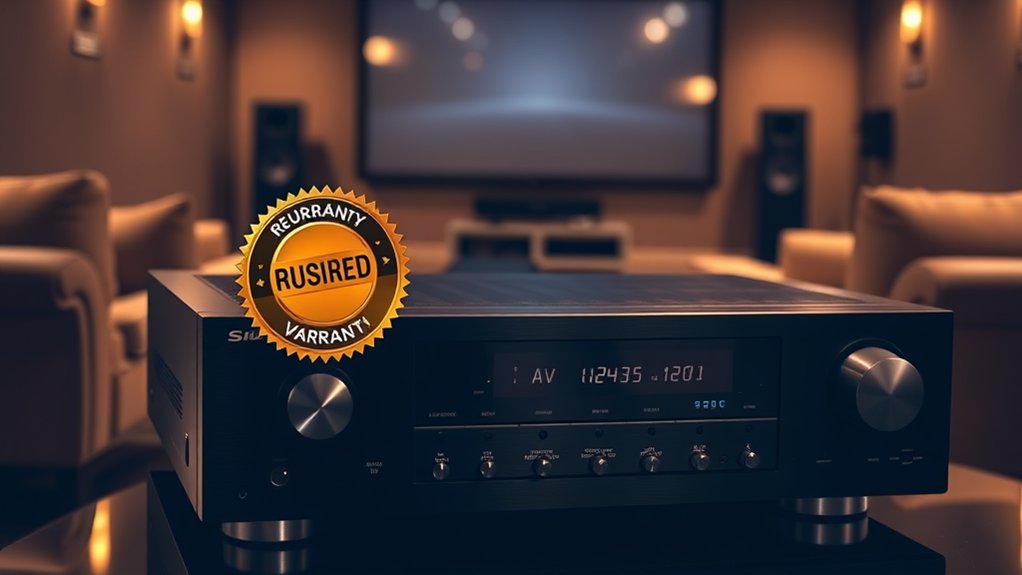If you’re on the hunt for AV receivers with Bluetooth and Wi-Fi, you’re in for a treat! Brands like Denon, Yamaha, and Marantz guarantee seamless connectivity for streaming. For instance, the Denon AVR-X series and Yamaha RX series provide sturdy wireless features, making your music streaming a breeze. Plus, with support for multi-room setups, you can control sound from anywhere. Curious about the latest models and their unique features? Let’s investigate further!
Key Highlights
- Most modern AV receivers, including Denon, Yamaha, and Sony, feature built-in Bluetooth for wireless audio streaming.
- Wi-Fi connectivity allows receivers to access online music services like Spotify and Amazon Music.
- Multi-room streaming capabilities are available on several models, enhancing audio experiences throughout the home.
- For instance, Marantz SR6014 includes HEOS for seamless wireless streaming across different rooms.
- Many receivers also support app integration, providing remote control over sources and volume adjustments.
Overview of Popular AV Receivers With Bluetooth and Wi-Fi Connectivity
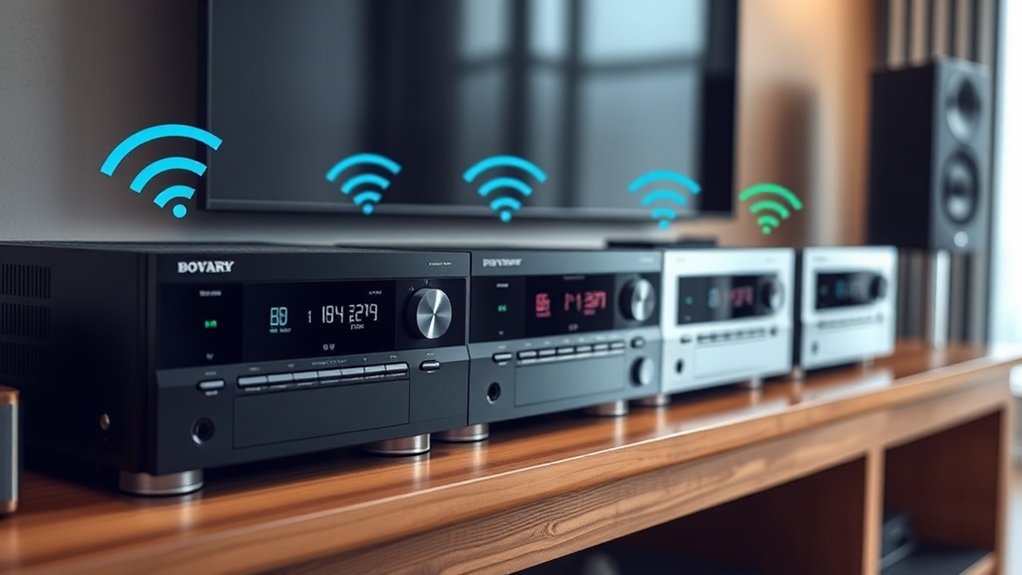
When you’re diving into the world of audio-visual receivers, the options can sometimes feel overwhelming—especially with so many brands touting Bluetooth and Wi-Fi connectivity.
Take the Denon AVR-X series, for example; it not only supports Bluetooth but likewise delivers Dolby Atmos and DTS:X sound, perfect for those dramatic movie nights. Additionally, the Denon models provide a full suite of 7 HDMI 2.1 sockets, allowing for flexible video and audio integration. These units are also equipped with high-quality DACs, enhancing your overall listening experience. Furthermore, these models can create an immersive audio experience similar to high-end sound systems, enhancing your enjoyment of movies and music.
The Denon AVR-X series combines Bluetooth connectivity with immersive Dolby Atmos and DTS:X sound for an unforgettable cinematic experience.
Then there’s Yamaha’s RX series, known for seamless multi-room streaming, which works great if you’ve got music playing throughout the house.
Don’t forget Sony’s STR series, which excels in advanced audio formats.
Onkyo and Marantz also join the party, offering THX certification and high-resolution audio support.
With all these choices, who knew picking an AV receiver could feel like a treasure hunt?
Wireless Features and Streaming Support
Having examined some of the most popular AV receivers that boast Bluetooth and Wi-Fi connectivity, it’s time to shift gears and dig into the wireless features and streaming support that make these devices so appealing.
You’ll find that most modern receivers support two-way Bluetooth, allowing you to stream audio from your devices while enjoying private listening through wireless headphones, all without annoying cords. At the same time, built-in Wi-Fi takes your experience further. It connects to your home network, unlocking services like Spotify and Amazon Music, plus enabling multi-room setups. Integrating a voice assistant means you can control everything hands-free, which is pretty convenient, right? Additionally, several of these receivers, such as the Marantz SR6014, offer HEOS wireless streaming capabilities for even more flexibility in your audio enjoyment. Seven-channel receivers can enhance your audio experience by allowing for more speaker configurations and advanced sound formats. With app support, switching sources or adjusting volume from anywhere in your home becomes a breeze.
Audio and Video Formats Supported
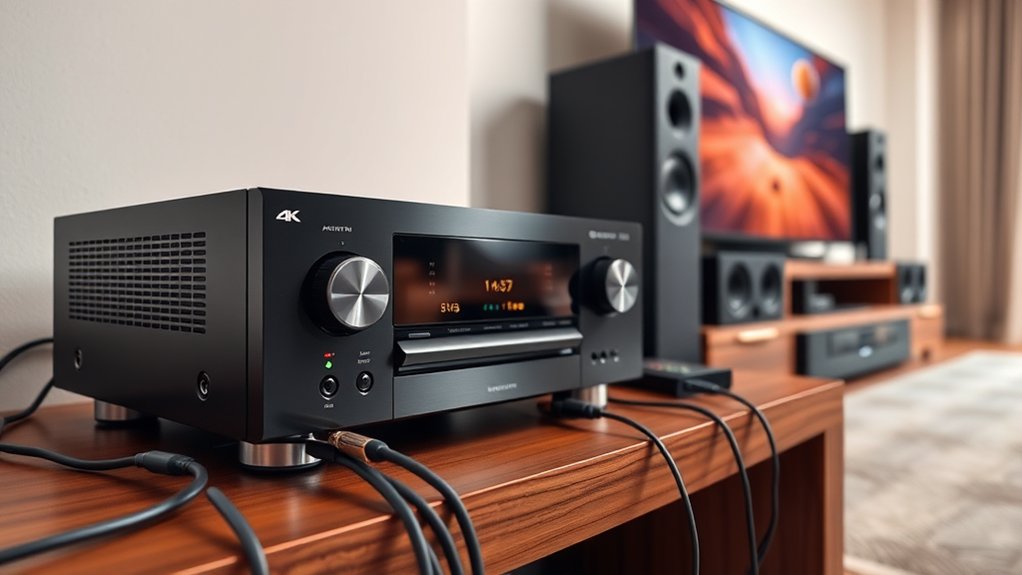
AV receivers today support a dazzling array of audio and video formats, ensuring you get the best out of your home entertainment system.
You can enjoy stunning resolutions up to 8K (yes, it’s a thing!) and 4K at refresh rates reaching 120 Hz. With color formats like RGB 4:4:4, your visuals pop beautifully. Furthermore, the right HDMI cable is essential to maximize the enhanced format specifications for optimal video quality.
On the audio front, support for Dolby Atmos and DTS:X guarantees immersive sound, making you feel like you’re right in the action. Plus, common USB formats—like MP3 and WAV—make playing music a breeze, though DRM-protected files give you trouble.
Calibration and Setup Technologies
Setting up your home theater can feel like a challenging task, but with the right calibration technologies, you’ll find the process more manageable (and maybe even a little fun!).
Auto calibration systems, for instance, use a microphone along with test tones to evaluate your speaker sizes, distances, and ideal volumes. Brands like Audyssey and YPAO help balance your sound, but don’t be surprised if they occasionally misinterpret a subwoofer’s needs.
If you’re feeling ambitious, manual calibration can heighten audio precision, even though it might feel intimidating at first.
And for those seeking a professional touch, advanced software like Dirac Live takes room correction to another level, even though it typically requires some expertise.
Who knew setup could get high-tech?
Range of Models and Price Points
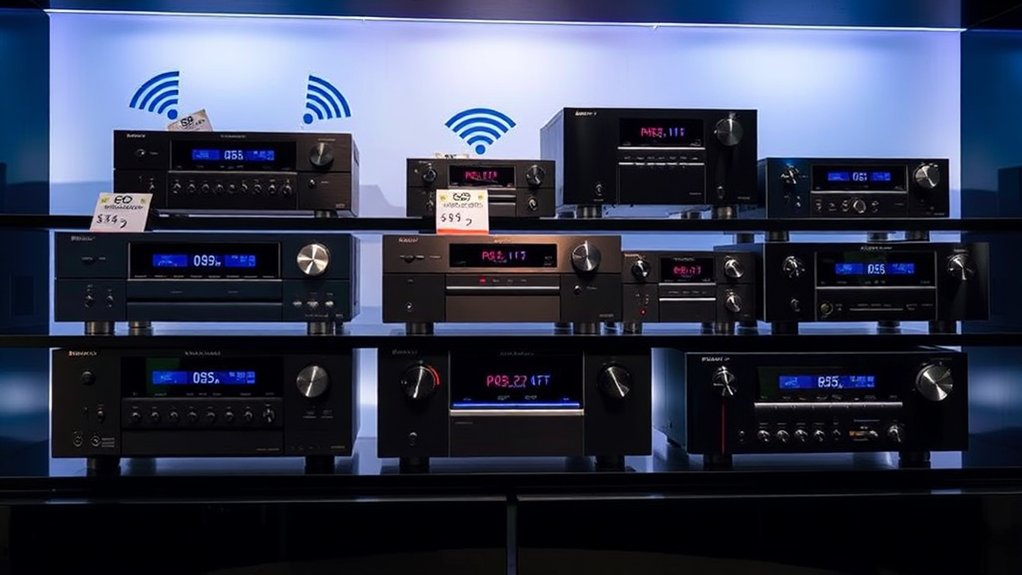
When you plunge into the world of home theater systems, understanding the various models and their price points can make all the difference in creating your ideal setup.
Entry-level receivers like the Yamaha RX-V4A or Denon AVR-S760H offer a solid starting point with basic wireless features and support for 5.1-7.2 channels—perfect for budget-conscious audiophiles.
Entry-level receivers such as the Yamaha RX-V4A and Denon AVR-S760H are ideal for budget-friendly audio enthusiasts seeking essential features.
As you move into the mid-range, models like the Denon AVR-X3800H and Yamaha RX-V6A provide advanced formats with more channels, enhancing your streaming experience.
For those who crave premium performance, high-end receivers like the NAD T 778 wow with their multi-room capabilities and superior power.
Additional Wireless and Connectivity Features
As you immerse yourself in the world of home entertainment, you’ll quickly realize that the additional wireless and connectivity features of today’s AV receivers can greatly improve your listening and viewing experience.
Many receivers come with built-in Bluetooth and Wi-Fi, enabling direct streaming from popular services like Spotify or TIDAL without extra equipment. Plus, those nifty manufacturer apps let you control volume and source switching right from your phone.
If you’re into multi-room setups, certain models sync audio across different spaces effortlessly, integrating with ecosystems like Sonos or HEOS for easier control. Additionally, with systems that support Dolby Atmos technology, you can experience an immersive sound environment that enhances your audio enjoyment.
And, with voice assistants like Alexa or Google Assistant helping you navigate your playlist, who wouldn’t want to kick back and enjoy?
Frequently Asked Questions
Can I Connect Multiple Devices Simultaneously via Bluetooth?
You can’t connect multiple Bluetooth devices simultaneously to an AV receiver. Most receivers only support one connection at a time, meaning you’ll have to switch devices if you want to change your audio source.
Do All Bluetooth Receivers Support High-Resolution Audio?
Not all Bluetooth receivers support high-resolution audio. Most only use basic codecs like SBC, limiting sound quality. For better audio fidelity, look for receivers that particularly support advanced codecs like aptX HD or LDAC.
How Does Wi-Fi Streaming Affect Audio Quality?
Wi-Fi streaming improves audio quality remarkably. You’ll enjoy higher fidelity because of broader bandwidth, supporting uncompressed formats. Plus, it prevents interruptions during playback, ensuring a superior listening experience compared to the limitations of Bluetooth.
Are Firmware Updates Necessary for Bluetooth and Wi-Fi Features?
Yes, firmware updates are vital for Bluetooth and Wi-Fi features. They improve performance, fix bugs, and bolster security. Keeping your AV receiver updated guarantees compatibility with new devices and streaming services, augmenting your overall experience.
Can I Control My Receiver With Voice Assistants?
Yes, you can control your receiver with voice assistants like Alexa or Google Assistant. Just confirm your receiver supports this feature and is connected to your Wi-Fi network for seamless voice command functionality.

